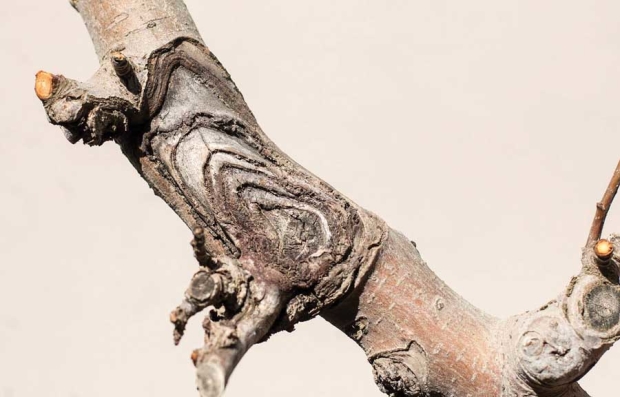
An example of a bulls-eye rot canker. (TJ Mullinax/Good Fruit Grower)
A Washington State University researcher has determined which chemical fungicides work to control bull’s-eye rot, a fungal infection partially blamed for a two-year shutdown of apple exports to China.
Christian Aguilar, a graduate student at WSU’s Tree Fruit Research and Extension Center in Wenatchee, Washington, has concluded that fungicide treatments both before and after harvest will reduce the rates of two strains of bull’s-eye rot — Neofabraea perennans and Cryptosporiopsis kienholzii — most common to apple growing areas in central Washington.
In pre-harvest trials in 2012, 2013 and 2014, Topsin M (thiophanate-methyl) worked the best of three candidates in reducing bull’s-eye rot, regardless of timing. In the postharvest trials, Penbotec (pyrimethanil) and Mertect (thiabendazole) delivered the best results out of four candidates.
Aguilar told growers at the North Central Washington Apple Day conference in late January in Wenatchee that they should treat their orchards and the fruit from those orchards postharvest if they have a history of bull’s-eye rot or if they see cankers.
“Most likely there will be fruit infection to follow,” she said.
Bull’s-eye rot causes cankers that spread on tree branches and brown, firm lesions that appear in concentric rings on fruit skin. Splashing water, such as by irrigation, spreads the disease. Tree inoculation is most common in April and in fall after harvest, while fruit inoculation is most common in September and October.
Bull’s-eye rot was one of three fungal diseases found by Chinese officials in a shipment of Washington apples, prompting them to shut down imports from 2012 to 2014.
Aguilar is part of a team of researchers working toward solutions under a five-year $1.9 million grant from the U.S. Department of Agriculture Foreign Agricultural Service Technical Assistance for Specialty Crops program.
Other researchers are examining the role of pruning and postharvest fungicides to control the other two diseases and searching for alternative pollinizers, which may be resistant to rot, to the commonly used Manchurian crab apple trees. Also, other researchers will test other chemical controls for bull’s-eye in the future, Aguilar said.
The search for alternate chemicals is important because Topsin-M and Mertect share the same mode of action, raising the potential for cross resistance, she noted in her final project report.
Growers are typically advised against using chemicals with the same mode of action both in the field and packinghouse. •
– by Ross Courtney






Leave A Comment